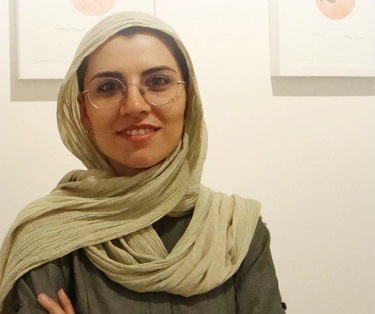|

Teratogenese is the title of a series of beautiful artistic works
by Zahra Husseini. These works were exhibited in Homa Gallery for 10 days. Her
artistic works are different from other artistic works and, as a result, many
lovers of art visited the exhibition in which her works had been showcased. She
exhibited 54 beautiful artistic works which deal with the formation of man's
embryo during the early stages of its genesis and evolution. As a creative
artist, Zahra Husseini has organized exhibitions in the Switzerland and
Germany. Each one of Zahra Husseini's works are associated with peculiar
secrets and ambiguities of the embryo.
Explaining about her collection of works exhibited in this gallery,
Zahra Husseini says: "This collection of works deal with cells which are
out of the body's control. Instead of coordinated multiplication and normal
growth, each cell might sometimes grow and multiply independently, regardless
of the rest of the body and out of any order or symmetry. My body is full of
such cells." We have made an interview with Zahra Husseini. Here is the text of
this interview: Q: Would you please introduce yourself? A: My name is Zahra Husseini. I was
born in 1980. I am originally from Shiraz. I received my BA of painting from
the University of Arts and Architecture in Tehran in 2005. Since that year, I
have professionally been involved in arts and artistic works. I have organized
exhibitions in Isfahan and Shiraz. Q: Why did you chose art as your favorite course of study? A: I was seriously interested in
painting since my childhood. I used to create paintings which were considered
as attractive by others. As a matter of fact, painting was a means for
expressing myself and my inner feelings. After receiving my high school
diploma, therefore, I entered the university and chose panting as my favorite
academic course of study. Q: Why did you select the embryo as the subject of your works? Does
it have any relation and connection with your physical disability? A: All of us have experienced an
embryonic period before our birth. I was interested in dealing with the
formation of man before his birth and during his embryonic stage. When I was
born, I had this physical disability, as a result of which one of my hands had
no fingers. This physical disability has certainly happened during the second
or third month of the embryonic stage. The mother, who is quite proximate to
the embryo, has no control over its growth procedure. This very incident was
quite important for me. I was not so much interested in the cause of this
incident or why it has happened. Rather, I was curious about it as a very
peculiar phenomenon. Q: When did you start your works in this collection? What kind of
technique have you used in them? A: I started it since 2011 and I
produced 55 works. I created my works through "paper pressing"
techniques. Colors have no role in my artistic works. I love new experiences
and do my best to refrain from repetitive works and themes. Q: The title that you have chosen for your exhibition is
Teratogenese. What does it mean? A: Teratogenese is derived from the
Greek word Teras, which means monster or vulnerable. It
refers to any environmental factor which can hurt the embryo before the birth
of the baby. Q: Is there any special relationship between embryo and the
techniques that you are applying? A: As you know, accidental events
play important roles in some techniques that are used in watercolor painting.
In other words, it is quite different to control the job in watercolor. There
are some similarities between the techniques which are used in the production
of these works and the process through which the embryo is formed. Q: How did you manage to receive enhanced inspirations and positive
attitudes from this phenomenon and ignore your physical disability? A: I do not consider physical
disability as a defect. It is actually a source of power. Physical disability
is a situation which cannot leave any negative effect on the lives of the
disabled individual. As a matter of fact, disability is a part of my being and
I have accepted it. Based on this kind of attitude, I was able to enhance my
abilities and even nurtured the idea of organizing some exhibitions abroad. Q: Would you please elaborate on your exhibitions in other
countries and the attitudes of the visitors of these exhibitions toward your
works? A: I have exhibited my works in two
exhibitions abroad. In one of these exhibitions, which was held in Bayern,
Germany, I was not personally present and I just dispatched a couple of my
works there. Visitors expressed great
interest in my works in the Bayern exhibition. The second exhibition was
organized in the Museum of Contemporary Arts in Geneva, the Switzerland. I went
to the Switzerland accompanied by two of my colleagues. I participated in this
exhibition with 29 works. All of these works were dealing with the issue of
embryo and the physique of the human beings. Fortunately, visitors expressed
great interest in my works and all my works were sold with proper prices. Q: What is your recommendation to our readers? A: Art is an issue which has its own
peculiar audience in different places. Those who are interested in art adopt
different approaches for expressing their inner thoughts. I have adopted the
language of images in order to express myself more sincerely and honestly. I
hope the best of wishes for all of those who are involved in arts, regardless
of this issue that they are disabled or not.
|